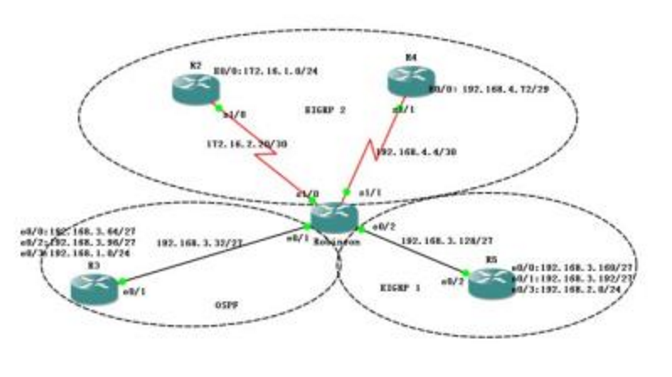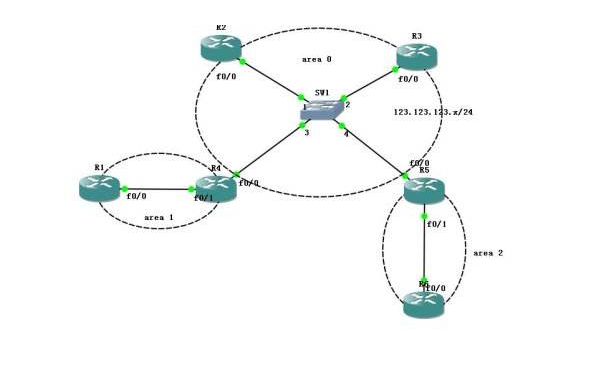EIGRP: Enhanced Interior Gateway Routing Protocol is an enhanced interior gateway routing protocol. Also translated as a reinforced interior gateway routing protocol. EIGRP is a proprietary protocol of Cisco Corporation (commercialized in 2013). EIGRP combines the Cisco-specific protocol for link state and distance vector routing protocols, uses the Dispersion Correction Algorithm (DUAL) to achieve fast convergence, and does not send periodic routing updates to reduce bandwidth usage. Supports Appletalk, IP, and Novell. And various network layer protocols such as NetWare.
OSPFOSPF (Open Shortest Path First) is an Interior Gateway Protocol (IGP) that is used to determine routes within a single autonomous system (AS). It is an implementation of the link state routing protocol and is part of the internal gateway protocol (IGP), so it operates inside the autonomous system. The famous Dijkstra algorithm (Dijkstra) is used to calculate the shortest path tree. OSPF is classified into two versions: OSPFv2 and OSPFv3. OSPFv2 is used on IPv4 networks and OSPFv3 is used on IPv6 networks. OSPFv2 is defined by RFC 2328, which is defined by RFC 5340. Compared to RIP, OSPF is a link state protocol, and RIP is a distance vector protocol.

As we all know, OSPF and EIGRP are both dynamic routing protocols. OSPF is standardized by the protocol, supports many manufacturers, and is widely used. The EIGRP protocol is invented by Cisco, a recognized leader in the network industry, and relies on its influence and absolute in the industry. Market share is also widely recognized by users. But what is the difference between these two protocols? Below we sort out the difference between your EIGRP and OSPF, and learn about it, hope to help you understand EIGRP and OSPF.
1. EIGRP is cisco-specific, and OSPF is a general-purpose protocol.
2. EIGRP is a distance vector protocol (some data is said to be hybrid), and OSPF is a link state protocol.
3. EIGRP supports automatic summarization, which can achieve automatic summarization at the boundary of ABC network, and also supports manual configuration; OSPF does not, summary must be manually configured
4. EIGRP is faster than OSPF because it saves optional successors in its topology map. Direct successor can be passed directly through optional successor.
5. The multicast address for EIGRP is 224.0.0.10 and OSPF is 224.0.0.5 and 224.0.0.6.
6. The path metric of EIGRP is composite, and OSPF is Cost type (of course, the general cost is calculated according to the bandwidth)
7. Although EIGRP supports route summarization, it does not have the concept of hierarchical routing, unlike OSPF.
8. In the establishment of the neighbor relationship, EIGRP does not have the complicated down-init-two way process of OSPF. As long as a router sees the neighbor's hello packet, it establishes an adjacency with it.
9. In the implementation of the summary function, EIGRP can be implemented on any interface of any router, while OSPF can only be implemented on ABR and ASBR, and its route summary is not interface-based.
10. EIGRP supports load balancing for unequal path metrics, while OSPF only supports load balancing for equal metrics.

11. EIGRP uses the DUAL algorithm to calculate the shortest path, and it uses a finite-state machine to track all routing packets, ensuring loop-free and subsequent routing options. OSPF uses the Dijikstra algorithm to calculate the shortest path, which does not use a finite state machine. Eigrp will select a feasible successor router as a successor router if there is a feasible successor router after losing the neighbor. If not, it will send a Query message to each EIGRP neighboring port in multicast mode, except for the original successor router port, because Query It is RTP. All the ACK packets sent by the neighbors will be received within the timeout period of the retransmission timeout RTO. If the ACK packet sent by the neighbor is not received in the RTO, the router will unicast to the ACK packet. The neighbor sends a Query once, so the Query is multicast for the first time and unicast for the second time.
12. EIGRP adjacency is established as long as the two parameters are met: K-value and AS number; and the establishment of OSPF adjacency requires multiple parameters: hello/dead timer, authentication password, area id, stub flag, and so on.
13. Finally, there are differences in their configuration and show commands. There are a lot of differences in this area, so I have to understand it slowly. For example, show ip ospf database in ospf corresponds to show ip eigrp topology in eigrp.
12 Woofer Speaker,Woofer Speaker 12 Inch,12 Inch Woofer Speaker,Pro Audio Tweeter Speaker
Guangzhou Yuehang Audio Technology Co., Ltd , https://www.yhspeakers.com
